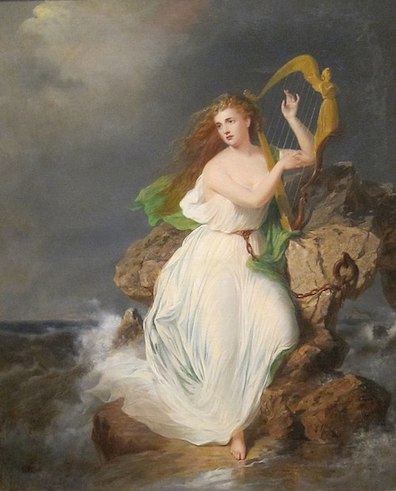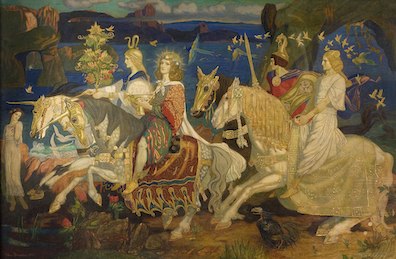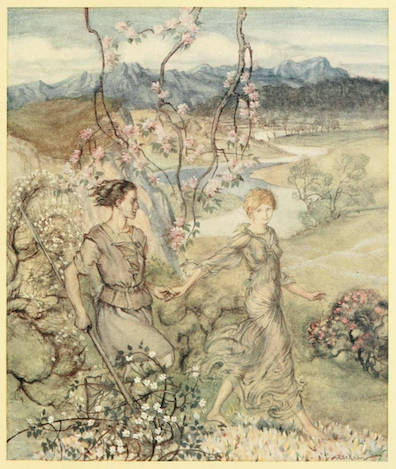Parody. "He is gone from mortal haunts: O'Dignam,
sun of our morning. Fleet was his foot on the bracken: Patrick
of the beamy brow. Wail, Banba, with your wind: and wail, O
ocean, with your whirlwind": immediately after his send-up of
Theosophy Joyce appends another brief riff on the funeral
theme, this one alluding to ancient bardic legends about the
pre-Christian gods. The goddess Banba was well known to
contemporary enthusiasts for Celtic mythology. Like her more
famous sister Erin, who is shown here surrounded by winds and
oceanic waters, she personifies Ireland.
The sisters Banba
(Banbha in modern spelling, pronounced BAHN-va), Ériu (Éire or
Erin in modern Irish), and Fódla (or Fótla, modern Fódhla or
Fóla) were members of the supernatural race of heroes and
magicians called the Tuatha Dé Danann. According to the
Lebor
Gabála (
Book of Invasions), they constituted the
fifth wave of invaders in Ireland. When the sixth and final
wave, the Milesians, conquered the island, they encountered
three regal sorceresses, each of whom wanted the land named
after her. After entertaining offers from Banba and Fódla they
agreed to name the country after the more opulent and powerful
Ériu (hence, Éire-land). Many ancient people invoked the name of
Banba, however, and that name persisted through the centuries.
Patricia Monaghan's
Encyclopedia of Celtic Mythology and
Folklore (2004) observes that "The name Banba remains
today as a poetic term for Ireland" (34).
Joyce could have encountered references to Banba in various 19th
century Irish writers. One was
James
Clarence Mangan, whose poems he devoured as a young man
and whom he praised extravagantly in an early essay. He must
have known the
Lament for Banba, which mourns Ireland's
"bondage" as a death:
O my land! O my love!
What a woe, and how deep,
Is thy death to my long-mourning soul!....
Other lands have their chiefs,
Have their kings, thou alone
Art a wife, yet a widow withal!
Alas, alas, and alas!
For the once proud people of Banba.
The high house of O'Neill
Is gone down to the dust,
The O'Brien is clanless and banned....
The language here is very different from the sentences in
Cyclops,
but one or two details suggest possible connections. Mangan
mourns the death of Banba while Joyce has her mourn the death of
Dignam. Mangan mentions Ulster's great O'Neill clans and
Munster's
O'Brien dynasty,
while Joyce evokes the Gaelic past by mock-heroically
transforming Paddy into the
noble
"
O'Dignam." While he does not attempt anything like an
imitation of the
Lament for Banba, it is not
inconceivable that he was thinking of it.
His imagination might also have been stimulated by reading
scholarly studies of the ancient legends. Slote, Mamigonian, and
Turner note that Standish O'Grady, an Irish historian whom he
seems to have consulted when writing about
Cuchulainn, liked to refer to
Ireland as Banba. The annotators observe that in
The History
of Ireland (1881) O'Grady wrote, "A writer of to-day will
employ Erin where the bards used Banba" (174). It is not
difficult to imagine Joyce encountering a sentence like that and
spinning out of his teeming linguistic brain some lines that
sounded bardic.
Nowhere else in Cyclops does one parodic aside
immediately follow another. That Joyce chose to do so here
suggests that, after exploring Theosophical ideas of an afterlife in which the human
spirit prepares for reincarnation,
he had more to say about non-Christian eschatology. Dignam is
now said to be, not exactly dead, but "gone from mortal
haunts," evoking the ancient Celtic idea of an
Otherworld. According to a popular belief that has persisted
through many centuries of Christian teaching, after the
Milesians conquered Ireland the Tuatha Dé Danann went
underground and became known by the term for earthen mounds, sidhe.
Their descendants, the "fairies" known as sidhe or aos
sí (pronounced SHEE) dwell in Tir na nÓg, the
Land of the Young, and legends say that some human beings have
visited that place. Perhaps Paddy, like Oisín, has left these
mortal haunts for immortal ones.

The Harp of Erin, 1867 oil on canvas painting by Thomas
Buchanan Read held in the Cincinnati Art Museum. Source:
Wikimedia Commons.

The Tuatha Dé Danann represented in Riders of the Sidhe, 1911
tempera on canvas painting by John Duncan held in the Dundee
Art Galleries and Museums. Source: Wikimedia Commons.

Arthur Rackham's Land of the Ever Young, an illustration in
Irish Fairy Tales (1920). Source: Wikimedia Commons.


